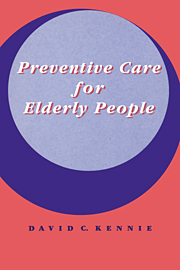Book contents
- Frontmatter
- Contents
- Acknowledgements
- 1 An overall perspective
- 2 What is health in old age?
- 3 The goals of health promotion for elderly people
- 4 A task for everyone
- 5 Critique of strategies
- 6 Cancer prevention
- 7 The prevention of non-cancerous health problems
- 8 Enhancing functional status
- 9 Strengthening support systems
- 10 Summary of problems and strategies
- 11 Tailoring strategies to individuals
- 12 Targeting, screening and surveillance in primary care
- 13 Practical aspects of implementation
- 14 The costs of preventive care and health promotion
- Index
12 - Targeting, screening and surveillance in primary care
Published online by Cambridge University Press: 15 October 2009
- Frontmatter
- Contents
- Acknowledgements
- 1 An overall perspective
- 2 What is health in old age?
- 3 The goals of health promotion for elderly people
- 4 A task for everyone
- 5 Critique of strategies
- 6 Cancer prevention
- 7 The prevention of non-cancerous health problems
- 8 Enhancing functional status
- 9 Strengthening support systems
- 10 Summary of problems and strategies
- 11 Tailoring strategies to individuals
- 12 Targeting, screening and surveillance in primary care
- 13 Practical aspects of implementation
- 14 The costs of preventive care and health promotion
- Index
Summary
Within the UK, preventive care for elderly people has historically centred around population screening and surveillance by the family doctor and his primary care team. In this chapter, therefore, I look at the primary care services as a resource for this older age group, review in detail the value of such screening, consider more efficient methods of targeting the frail elderly and discuss the implications of recent government legislation mandating an annual health check being offered to those over 75 years.
Primary care as a resource for elderly people
In the community, primary care services usually consist of family practitioners or other ‘generalist’ doctors who serve as first point of contact for elderly patients and who provide comprehensive, ongoing care. Community nurses also figure prominently in community care, either being directly employed by the family doctor's practice or liaising closely with it. Primary care is also represented by a wide range of other health professionals who work as part of a multidisciplinary team, or network, with the practice. In some countries, family doctors have a statutory responsibility to consider their patients' social needs and to make referral through the appropriate social services.
Some countries still have problems in providing geographically and financially accessible care to their older populations or in making this readily available on a 24-hour, 7-day week basis.
- Type
- Chapter
- Information
- Preventive Care for Elderly People , pp. 271 - 289Publisher: Cambridge University PressPrint publication year: 1993



